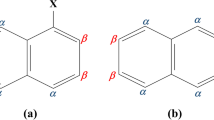Abstract
This article introduces potential wells around nuclei and their roles in chemical bonds. The approach uses one-electron Bohr atomic model concept. Multi-electron atoms are converted to one-electron atoms by grounding all inactive, non-reacting electrons using the Apparent Nuclear Charge (ANC) and Electron Shielding Effect (ESE) concepts introduced in earlier publications. Then, the resulting two one-electron atoms and their potential wells are utilized to obtain the related chemical bond length. The methodology is applicable to all elements of periodic table without a need for any additional tool. To test the concept, calculated bond lengths were compared to experimental ones for about 90 different bonds, which showed an average error of less than 5%. The article discusses some nontraditional views for chemical bonds which may contradict the traditional beliefs in chemistry. Hopefully, readers would consider the calculated results in support of the presented views. Attached to this article is a computer software program which was prepared with sample input and output files for readers. The software can be utilized to obtain any interested bond length. The software is applicable to all elements in the periodic table up to the element Hassium with the atomic number of 108.
Graphical abstract

Nuclear potential well associated with the electron of hydrogen atom












Similar content being viewed by others
References
Zadeh DH (2019) A new approach to estimate atomic energies. J Mol Model 25:366. https://doi.org/10.1007/s00894-019-4259-1
Zadeh DH (2019) Atomic shells according to ionization energies. J Mol Model 25(8):251 https://link.springer.com/article/10.1007/s00894-019-4112-6
Zadeh DH (2017) Electronic structures of elements according to ionization energies. J Mol Model 23(12):357 https://link.springer.com/article/10.1007/s00894-017-3534-2
Politzer P, Zadeh DH (1994) Bond-breaking energies for 2, 2'-dichlorodiethyl sulfide (sulfur mustard) in media of different dielectric constants. J Phys Chem 98:1576–1578. https://doi.org/10.1021/j100057a008
Zadeh DH, Grice ME, Concha MC, Murray JS, Politzer P (1995) Nonlocal density functional calculation of gas phase heats of formation. J Comput Chem 16(5):654–658. https://doi.org/10.1002/jcc.540160513
Bohr N (1913) The spectra of helium and hydrogen. Nature 92:231–232. https://doi.org/10.1038/092231d0
Bohr N (1913) On the constitution of atoms and molecules, part I. Philos Mag 26(151):1–24. https://doi.org/10.1080/14786441308634955
Hehre WJ, Radom L, Schleyer PVR, Pople JA (1986) Ab initio molecular orbital theory. Wiley, New York; https://doi.org/10.1002/jcc.540070314
Sharpe AG (1986) Inorganic chemistry. Longman, London and New York; https://doi.org/10.1002/bbpc.19860901144
Szabo A, Ostlund NS (1989) Modern quantum chemistry. McGraw-Hill, New York ISBN-10: 0486691861
Atkins PW (1986) Physical chemistry. W.H. Freeman and Company, New York ISBN-10: 0716731681
Drago RS (1977) Physical methods in chemistry. Saunders College Publishing, Philadelphia ISBN-10: 0721631843
Pauling L, Wilson EB (1985) Introduction to quantum mechanics with applications to chemistry. Dover Publications, INC., New York ISBN-10:0486648710
Herzberg G (1945) Atomic spectra and atomic structure. Dover Publications, New York ISBN-10:0486601153
Johnson CS, Pedersen LG (1986) Problems and solutions in quantum chemistry and physics. Dover Publications, Inc., New York ISBN-10:0486151530
Schrödinger E (1926) An undulatory theory of the mechanics of atoms and molecules. Phys Rev 28(6):1049–1070. https://doi.org/10.1103/PhysRev.28.1049
Hartree DR (1928) The wave mechanics of an atom with a non-coulomb central field. Math Proc Camb Philos Soc 24(1):111. https://doi.org/10.1017/S0305004100011920
Hartree DR, Hartree W (1935) Self-consistent field, with exchange, for beryllium. Proc Royal Soc London, A 150((869):9. https://doi.org/10.1098/rspa.1935.0085
Slater JC (1928) The self consistent field and the structure of atoms. Phys Rev 32(3):339–348. https://doi.org/10.1103/PhysRev.32.339
Gaunt JA (1928) A theory of Hartree’s atomic fields. Math Proc Camb Philos Soc 24(2):328–342. https://doi.org/10.1017/S0305004100015851
Slater JC (1930) Note on Hartree’s method. Phys Rev 35(2):210–211. https://doi.org/10.1103/PhysRev.35.210.2
Moller C, Plesset MS (1934) Note on an approximation treatment for many-electron systems. Phys Rev 46:618. https://doi.org/10.1103/PhysRev.46.618
Feynman RP (1939) Forces in molecules. Phys Rev 56:340. https://doi.org/10.1103/PhysRev.56.340
Hohenberg P, Kohn W (1964) Inhomogeneous electron gas. Phys Rev B 136:864. https://doi.org/10.1103/PhysRev.136.B864
March NH (1982) Electron density theory of atoms and molecules. J Phys Chem 86:2262. https://doi.org/10.1021/j100209a022
Milne EA (1927) The total energy of binding of a heavy atom. Proc Camb Philos Soc 23:794. https://doi.org/10.1017/S0305004100015589
Lide DR (2007) CRC handbook of chemistry and physics, CRC Press LLC, Boca Raton, FL. ISBN: 0849304881, ISBN13: 9780849304880
Olmsted JA, Williams GM (2011) Chemistry, 5th edition. Wiley, New York ISBN-13: 978–0471478119, ISBN-10: 0471478113
Huheey JE, Keiter EA, Keiter RL (1993) Inorganic chemistry: principles of structure and reactivity. HarperCollins College Publishers, New York, ISBN-13: 978–0060429959, ISBN-10: 006042995X
Cottrell TL (1958) The strengths of chemical bonds. Butterworths, London. https://doi.org/10.1002/ange.19600721618
Author information
Authors and Affiliations
Corresponding author
Ethics declarations
Conflict of interest
The authors declare no competing interests.
Additional information
Publisher’s note
Springer Nature remains neutral with regard to jurisdictional claims in published maps and institutional affiliations.
This article is submitted in honor of Prof. Peter Politzer who admitted the author to his research group, taught, helped, and supported him until he could make contributions to theoretical physical chemistry.
Rights and permissions
About this article
Cite this article
Zadeh, D.H. Molecular theory considering nuclear potential wells. J Mol Model 27, 185 (2021). https://doi.org/10.1007/s00894-021-04804-2
Received:
Accepted:
Published:
DOI: https://doi.org/10.1007/s00894-021-04804-2




